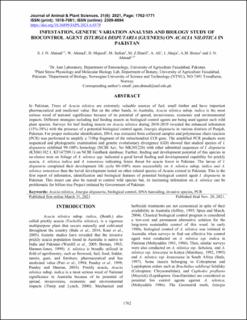| dc.contributor.author | Ahmad, SJN | |
| dc.contributor.author | Ahmad, W | |
| dc.contributor.author | Majeed, D | |
| dc.contributor.author | Sufian, M | |
| dc.contributor.author | Sharif, MZ | |
| dc.contributor.author | Ali, A | |
| dc.contributor.author | Ahuja, Ishita | |
| dc.contributor.author | Bones, Atle M. | |
| dc.contributor.author | Ahmad, JN | |
| dc.date.accessioned | 2022-03-28T12:00:57Z | |
| dc.date.available | 2022-03-28T12:00:57Z | |
| dc.date.created | 2022-01-11T10:13:55Z | |
| dc.date.issued | 2021 | |
| dc.identifier.citation | Journal of Animal and Plant Sciences. 2021, 31 (6), 1762-1771. | en_US |
| dc.identifier.issn | 2309-8694 | |
| dc.identifier.uri | https://hdl.handle.net/11250/2988012 | |
| dc.description.abstract | In Pakistan, Trees of Acacia nilotica are extremely valuable sources of fuel, small timber and have important pharmaceutical and medicinal value. But on the other hands, in Australia, Acacia nilotica subsp. indica is the most serious weed of national significance because of its potential of spread, invasiveness, economic and environmental impacts. Different strategies including leaf feeding insects as biological control agents are being used against such wild plant species. Surveys for leaf feeding insects on Acacia nilotica during 2018-2019 revealed the enhanced infestation (15%-38%) with the presence of a potential biological control agent, Isturgia disputaria in various districts of Punjab, Pakistan. For proper molecular identification, DNA was extracted from collected samples and polymerase chain reaction (PCR) was performed to amplify a 710bp fragment of the mitochondrial COI gene. The amplified PCR products were sequenced and phylogenetic examination and genetic evolutionary divergence (GD) showed that studied species of I. disputaria exhibited 99-100% homology (NCBI Acc. No MK301226) with other submitted sequences of I. disputaria (KX861182.1, KF147289.1) on NCBI GenBank database. Further, feeding and development potential of this species in no-choice tests on foliage of A. nilotica spp. indicated a good larval feeding and developmental capability for prickly acacia, A. nilotica indica and A. tomentosa indicating future threat for acacia forest in Pakistan. The larvae of I. disputaria completed their development life cycle 80-100% more successfully on A. nilotica subsp. indica and A. nilotica tomentosa than the larval development tested on other related species of Acacia existed in Pakistan. This is the first report of infestation, identification and biological features of potential biological control agent I. disputaria in Pakistan. This insect can also be reared to control wild species but, its increasing infestation on A. nilotica can be problematic for billion tree Project initiated by Government of Pakistan | en_US |
| dc.language.iso | eng | en_US |
| dc.publisher | Pakistan Agricultural Scientists Forum (PAS FORUM) | en_US |
| dc.rights | Navngivelse-DelPåSammeVilkår 4.0 Internasjonal | * |
| dc.rights.uri | http://creativecommons.org/licenses/by-sa/4.0/deed.no | * |
| dc.title | Infection, genetic variation analysis and biology study of biocontrol agent Isturgia disputaria (Guenees) on Acia nilotica in Pakistan. | en_US |
| dc.type | Journal article | en_US |
| dc.description.version | publishedVersion | en_US |
| dc.source.pagenumber | 1762-1771 | en_US |
| dc.source.volume | 31 | en_US |
| dc.source.journal | Journal of Animal and Plant Sciences | en_US |
| dc.source.issue | 6 | en_US |
| dc.identifier.doi | 10.36899/JAPS.2021.6.0379 | |
| dc.identifier.cristin | 1978049 | |
| cristin.ispublished | true | |
| cristin.fulltext | original | |

